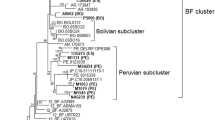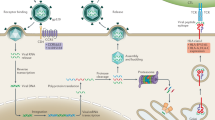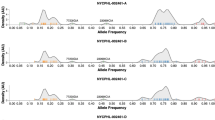Abstract
Although much is now known of the strain variation among the type-1 human immunodeficiency virus (HIV-1), which is the cause of AIDS (acquired immune deficiency syndrome) in the United States, Europe, and Central Africa, much less is yet known about a second group of viruses that have been found in West Africans. One member of this group, named human T-cell lymphotropic virus type 4 (HTLV-4), has been isolated from healthy Senegalese (ref. 1). Another is the virus isolated from West Africans with AIDS-like illness and originally called LAV-2 but now renamed HIV-2 (refs 2 and 3). Both these viruses seem to be less closely related to HIV-1 than they are to a virus of healthy African green monkeys4,5, known variously as simian T-cell lymphotropic virus type 3 (STLV-3) or simian immunodeficiency virus (SIV), which in turn is related to viruses isolated from healthy sooty mangabeys6,7 and captive macaques6,8–;10 with a form of immunodeficiency (to distinguish these viruses they are referred to as STLV-3 (or SIV)agm, STLV-3mac, or STLV-3smm). To clarify the relationship between the various HIVs, STLV-3s and HTLV-4 we are determining and comparing the molecular and biological characteristics of several of them. Following our recent publication11 of a restriction-site map of STLV-3agm, we now report that the equivalent map of three isolates of HTLV-4 is remarkably similar to it. In addition we present comparative sequence data on the long terminal repeats (LTR) of HTLV-4, STLV-3agm, HIV-1 and HIV-2, together with evidence that cloned HTLV-4 uses the same receptor as HIV-1 and induces some, but not all, of the cytopathic effects attributed to most isolates of HIV-1 and HIV-2.
This is a preview of subscription content, access via your institution
Access options
Subscribe to this journal
Receive 51 print issues and online access
$199.00 per year
only $3.90 per issue
Buy this article
- Purchase on Springer Link
- Instant access to full article PDF
Prices may be subject to local taxes which are calculated during checkout
Similar content being viewed by others
References
Kanki, P. J. et al. Science 232, 238–243 (1986).
Clavel, F. et al. Science 233, 343–346 (1986).
Clavel, F. et al. Nature 324, 691–695 (1986).
Kanki, P. J. et al. Lancet i, 1330–1332 (1985).
Kanki, P. J., Alroy, J. & Essex, M. Science 230, 951–954 (1985).
Murphey-Corb, M. et al. Nature 321, 435–437 (1986).
Fultz, P. N. et al. Proc. natn. Acad. Sci. U.S.A 83, 5286–5290 (1986).
Kanki, P. J. et al. Science 228, 1199–1201 (1985).
Daniel, M. D. et al. Science 228, 1201–1204 (1985).
Benveniste, R. E. et al. J. Virol. 60, 483–490 (1986).
Hirsch, V. et al. Proc. natn. Acad. Sci U.S.A. 83, 9754–9758 (1986).
Lowenstein, L. J. et al. Int. J. Cancer 38, 563–574 (1986).
Coffin, J. M. Cell 46, 1–4 (1986).
Yamamoto, N. et al. Med. Microbiol Immun. 173, 57–64 (1984).
Miyoshi, I. et al. in Retroviruses in Human Lymphoma/ Leukemia (eds Masano, M., Sugano, H., Sugimura, T. & Weiss, R. A.) 121–127 (Japan Sci. Soc. Press/VNU Science Press, Utrecht, 1985).
Watanabe, T. et al. Virology 144, 59–65 (1985).
Hayami, M. et al. Int. J. Cancer 33, 179–183 (1984).
Alter, J. J. et al. Science 226, 549–552 (1984).
Graffi, A. & Gimmy, J. Naturwissenschaften 44, 518–519 (1957).
Gross, L. Proc. Soc exp. Biol. Med. 112, 939–945 (1963).
McClure, H. M. et al. Cancer Res. 34, 2745–2757 (1974).
Mammerickx, M., Dekegel, D., Burny, A. & Portetelle, D. Vet. Microbiol 1, 347–350 (1976).
Onuma, M., Baumgartener, L. E., Olson, C. & Pearson, L. D. Cancer Res. 37, 4075–4081 (1977).
Zenke, M. et al. EMBO J. 5, 387–397 (1986).
Sen, R. & Baltimore, D. Cell 46, 705–716 (1986).
Jones, K. A., Kadonaga, J. T., Luciw, P. A. & Tijan, R. Science 232, 755–759 (1986).
Rosen, C. A., Sodroski, J. G. & Haseltine, W. A. Cell 41, 813–823 (1986).
Okamoto, T. & Wong-Staal, F. Cell 47, 29–35 (1986).
Milman, G. & Herzberg, M. Somatic Cell Genet. 7, 161–170 (1981).
Dorsett, D. L., Ilana, K. & Winocour, E. J. Virol 48, 218–228 (1983).
Popovic, M., Sarngadharan, M. G., Read, E. & Gallo, R. C. Science 224, 497–500 (1984).
Dalgleish, A. G. et al. Nature 312, 763–767 (1984).
Klatzmann, D. et al. Nature 312, 767–768 (1984).
McDougal, J. S. et al. Science 231, 382–385 (1986).
Maddon, P. J. et al. Cell 47, 333–348 (1986).
Ceuppens, J. L., Goodwin, J. S. & Searles, R. P. Cell. Immun. 64, 277–292 (1981).
Folks, T. et al. Science 231, 600–602 (1986).
Lifson, J. D., Reyes, G. R., McGrath, M. S., Stein, B. S. & Engleman, E. G. Science 232, 1123–1127 (1986).
Sodroski, J., Goh, W. C., Rosen, C., Campbell, K. & Haseltine, W. A. Nature 322, 470–474 (1986).
Mullins, J. I., Brody, D. S., Binari, R. C. Jr & Cotter, S. M. Nature 308, 856–858 (1984).
Mullins, J. I., Casey, J. W., Nicolson, M. O. & Davidson, N. Nucleic Acids Res 8, 3287–3305 (1980).
Sanchez-Pescadcor, R. et al. Science 227, 484–492 (1985).
Poncz, M., Solowiejczyk, M., Schwartz, E. & Surrey, S. Proc. natn. Acad. Sci. U.S.A. 79, 4298–4302 (1982).
Author information
Authors and Affiliations
Rights and permissions
About this article
Cite this article
Kornfeld, H., Riedel, N., Viglianti, G. et al. Cloning of HTLV-4 and its relation to simian and human immunodeficiency viruses. Nature 326, 610–613 (1987). https://doi.org/10.1038/326610a0
Received:
Accepted:
Issue Date:
DOI: https://doi.org/10.1038/326610a0
This article is cited by
-
Silencers of HTLV-1 and HTLV-2: the pX-encoded latency-maintenance factors
Retrovirology (2019)
-
Characterization of novel safe lentiviral vectors derived from simian immunodeficiency virus (SIVmac251) that efficiently transduce mature human dendritic cells
Gene Therapy (2000)
-
Specific incorporation of cyclophilin A into HIV-1 virions
Nature (1994)
-
Use of evolutionary limitations of HIV-1 multidrug resistance to optimize therapy
Nature (1993)
-
Generation, characterization and cross-reactivities of monoclonal antibodies against the p24 core protein and the gp130 envelope glycoprotein of HIV-2ben
Medical Microbiology and Immunology (1993)
Comments
By submitting a comment you agree to abide by our Terms and Community Guidelines. If you find something abusive or that does not comply with our terms or guidelines please flag it as inappropriate.



